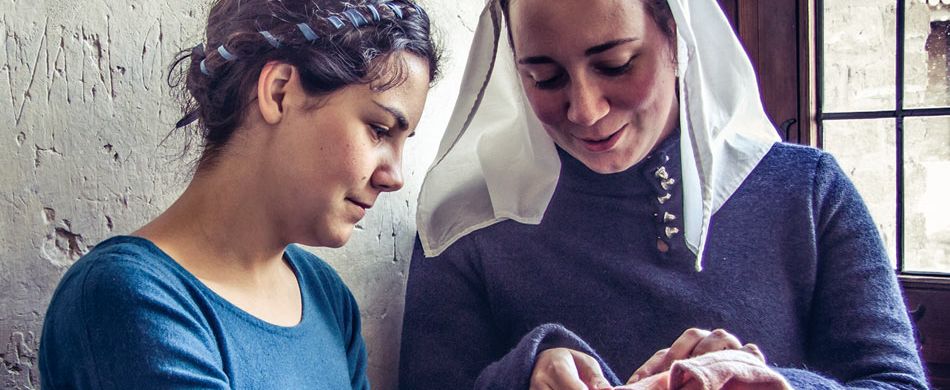Clothing Choices
EVER since Adam and Eve “sewed fig leaves together to cover themselves” (Genesis 3:7), clothing has enthralled humanity. Down through the centuries, and in every culture, social status dictated clothing choices. Indeed, the theme “clothes make the man” was the inspiration for Mark Twain’s The Prince and the Pauper, a fictional piece in which two look-alike boys, one prince and one pauper, exchange clothes and roles.
During Anthony’s century, a glance around the marketplace revealed people’s social status. Beggars wore soiled, ragged cast offs from the wealthy. Lower class, working men and women donned practical woolen tunics, hose, and simple head coverings. In contrast, upper classes could afford fashionable colors, fabrics, and styles. They often sported silks and furs like vair (squirrel), ermine, and fox. For noble men and women, long, flaring sleeves were stylish and provocative, since showing one’s wrist or elbow was considered risqué.
Simple clothing
For the laity who had voluntarily embraced a life of penance (conversion), clothing was a concern. Penitents sought to live and look humble. The ‘look’ related to their garb. After a single sentence introduction and the Sign of the Cross, the Rule of 1221 for the voluntary penitents immediately addresses clothing. Clothing must be of “humble, undyed cloth… unless for evident and necessary cause a temporary dispensation be given.” Wool was the only “fur” permitted. The throat and sleeves of garments were to be closed, “laced up.” Penitents “are not to wear silken or dyed veils and ribbons.” They could use “leather purses and belts sewed in simple fashion without silken thread, and no other kind. Also other vain adornments they shall lay aside.”
Although Anthony had no role in composing the Rule of 1221 (in that year, he had just entered the Franciscans), he clearly understood why the Rule addressed clothing in the first four of its 39 statutes. In his sermon notes for the Nativity of John the Baptist, Anthony writes, “Unless someone first puts forth their foot to tread down temporal things, he cannot put forth his hand to take hold of heavenly things. Temporal things must decline, so that afterwards eternal things may rise” (Sermons for Sundays and Festivals IV, p. 283; translated by Paul Spilsbury, Edizoni Messaggero Padova).
Lilies in the filed
Clothing is an evident temporal necessity. Conquering concern for it mirrors Jesus’ Sermon on the Lilies of the Field. These flowers are unconcerned about clothing yet “not even Solomon, in all his glory, was arrayed like one of these” (Matthew 6:29).
Anthony addresses rich clothing in his sermon notes for the First Sunday after Pentecost. He offers a lengthy reflection on the rich man and the beggar Lazarus. “‘There was a certain rich man who was clothed in purple and fine linen…’ (Lk 16.19). The purple stands for worldly dignity, the linen for costliness of clothing… Purple is the color of royal robes. It is a dye found in certain marine shells when they are cut with iron… How reminiscent of the poor, who are despoiled of their goods… when… that ‘certain rich man,’ worldly power, slits them open with the force of iron, and extracts their life-blood, their livelihood, to make for himself the purple dye of earthly dignity” (Sermons II, p. 9).
Keeping the mean
The stipulation in the Rule of “humble, undyed cloth” is an unmistakable call to humility and to a relinquishment of power. Humility runs in two directions. Penitents are not to parade wealth nor are they to court praise for appearing destitute. Anthony addressed this temptation. “Excess in dirty and ragged clothing is as much a form of boasting as too much splendour. One should keep to the mean… whatever they do is just outward show, painted in false colors. The Gloss says, ‘To seem different from other men, they make display of a lowliness beyond other men.’…He who gives the good he does for human praise, is selling something of great value for a cheap price” (Sermons IV, p. 150).
The Rule of 1221 limits the amount of money which may be spent on each garment to about $6 per yard of fabric. This is a reasonable amount so that penitents can dress moderately. A lady’s undergarment might require 2.5 yards of fabric, and could, therefore, cost about $15 by today’s standards. A woman’s dress might require 10 yards of fabric ($60) and a cape could require 3 yards ($18). These prices are comparable to what one can find on internet ordering sights or in lower cost department stores.
Root of all virtues
The clothing stipulation placed at the beginning of the Rule of 1221 was meant to foster humility. Humility, Anthony wrote, “has to be first formed among the virtues… from it comes the motive force of all good work, having great dominion over the rest as the mother and root of all virtues… Blessed Bernard says, ‘The deeper you lay the foundation of humility, the higher the building rises.’ … St. Gregory says, ‘A man who ties to acquire virtue without humility is like a man trying to carry dust in a wind’” (Sermons I, p. 326).
Anthony recognizes that growth in penance, conversion, and humility take time. “‘No-one gets to the top at once,’ and so we must little by little get used to despising riches and pleasures. ‘The shortest way to [heavenly] riches is by despising [earthly] riches.’ And again, ‘I am great, and born to greater things than to be a slave to my body’” (Sermons IV, p. 284).
The purpose of the Rule of 1221 is personal sanctification so as to gain eternal life. Anthony understood exactly: “the hope of eternal life does not spring from bodily affliction, but from humility of mind” (Sermons III, p. 393).



